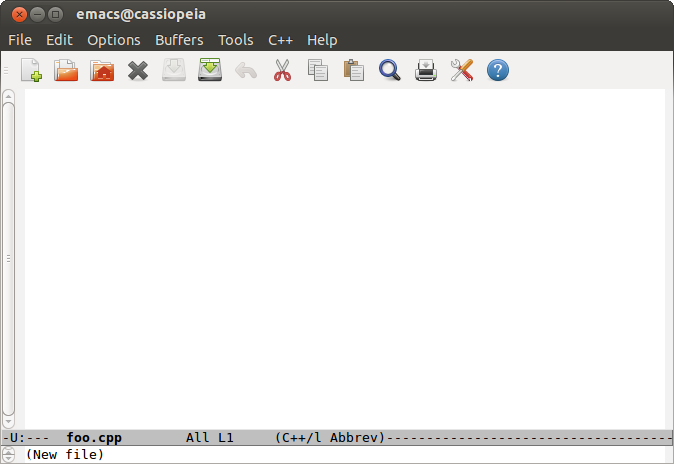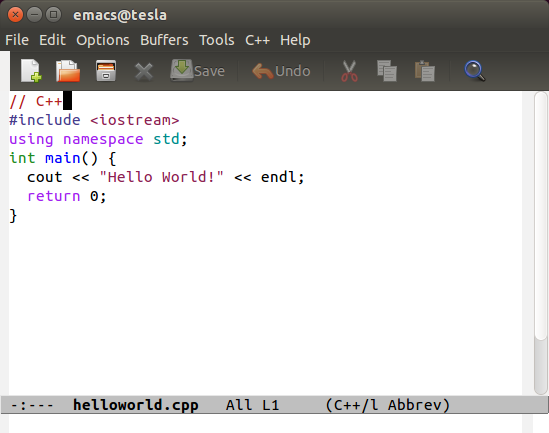
Go up to the Tutorials table of contents page
This tutorial is meant to get you up and running with editing, compiling, and executing a program in a Unix-like environment. There are a number of options that you can use to do this, depending on what operating system you are using and how much time you want to spend installing software.
We recommended using VirtualBox, a free virtual machine software package. This will allow you to run Linux on your home machine without needing to re-install anything. Directions for setting up and how to use VirtualBox can be found at Tutorial 1: Introduction to UNIX: VirtualBox use. This will require downloading a hard drive image that we provide.
There are other options available:
clang++ --version - if you get “Command not
found”, you will need to install Xcode from the App Store, and then
install the Command Line Tools (under Preferences - Downloads). In newer
versions of macOS, after typing clang++ --version, a pop-up
should appear asking if you would like to install command line developer
tools. Also note that you cannot load up Emacs easily from a command
line, but you can load it up as you would any other application.
When you install Linux, there are a number of graphical user interfaces – or window managers – that one can use. Think of how MS Windows is different than macOS, and you get the idea. The one we are using is Gnome. Gnome (pronounced guh-NOME) is a user interface that is specific to UNIX machines. The interactions with the GUI are a bit different, but the same concepts. One can interact with Gnome really quickly once one gets used to the new interface. You can see a screen shot of it here.
Unix is a very powerful operating system that has been around, in one form or another, for almost 40 years. The fact that it still exists attests to how powerful it can be for completing tasks on a computer. The reason it is not more widely adopted is because it is not very easy to use or intuitive – it was written by computer programmers for computer programmers. While the people in this course are certainly capable of learning it, many people just want a computer to work, and to run an Office suite and a set of Internet programs such as a browser. For those users, an easier to use operating system (such as Windows or macOS) is often better. Unix is coming more into the mainstream lately with the increased popularity of Linux, as well as the fact that macOS is built upon a Unix operating system (FreeBSD, in particular).
The word “Unix” can mean any Unix-like operating system. There are many available – Linux, FreeBSD, Solaris, macOS, etc. We will be using the word Unix in this class to mean whichever Unix-like environment we are using for this course.
A quick note: Unix IS CASE SENSITIVE. Thus, foo, Foo, FOO, and FoO are all different, and allowable, file names. This causes problems with Windows, which sees all those names as the same thing. So be careful about your cases!
First, you need to load up a terminal. For those who have used the Windows command prompt, it is a somewhat similar interface.
Here is a quick primer of basic Unix commands. Try each of these out. The idea is for you to be able to manipulate files and directories – the full Unix tutorial starts next week.
ls will show the contents of the current directory.
‘ls’ stands for ‘list’, but without the ‘i’ and the ‘t’.cd pdr will change to the pdr directory –
in other words, it changes the current working directory to whatever you
specify. You should notice the text at the beginning of the line change:
the prompt will help you keep track of which directory you are
in. To go up a directory, you can enter cd .. (notice the
one space and then two periods). Also, you can enter cd -
to jump to the previous directory you were in (the Ctrl-Z of directory
hopping). Finally, typing cd with nothing after it will
move you back to your home directory.mkdir and remove them by
rmdir. This is the same as creating a folder in Windows
Explorer. A directory that is not empty cannot be removed. For now, we
recommend that any directory names (or file names) only have letters,
digits, or the underscore in their names (there are ways around that,
but they are complicated).rm.That’s it for the Unix tutorial for now. There are many further tutorials online, feel free to read those. You can do all your editing in your desktop folder – this way, if you want to rename or move your files, you can use Windows Explorer to do so (there are Unix ways to do it, and we’ll get to those later).
First, you will need to open a terminal (as in the previous section), from which we will load up an editor. We will be using the Emacs editor for all our examples, but you are welcome to use any editor that is not an integrated development environment (IDE). Whatever you decide to use, know that you will be expected to be familiar with it! This includes keyboard shortcuts.
To load up the editor, enter emacs & into the
terminal. The ampersand (&) at the end is very
imporant! This tells the terminal to start the emacs
process in the background, which means you can continue to use the
terminal while emacs is open.
If you are using macOS, you can open Emacs from the Dock or Spotlight if the above instructions do not work.
You should now have Emacs loaded and running – it should look something like the following.

All of the mouse commands in Emacs have keyboard shortcuts. Eventually, you will want to learn the shortcuts, as they are much faster to enter once they are known. To help you with getting used to them, we have provided the shortcuts for the commands below.
The first commands in Emacs that we will learn will use the control
key (even on macOS!). For example, the save command is listed as
C-x C-s. This means hit Control-x then Control-s. We will
be going over Emacs command in more detail later. For now, remember that
if you get stuck, hit C-g (Control-g) a few times, and that
should un-stick it.
We recommend you create a new directory for the rest of this tutorial
(mkdir tutorial). cd into that directory.
Next, let’s open up a new file. To do that, go to File->Open
(C-x C-f). Enter the name of the file
(helloworld.cpp). Note that if the file does not exist,
then it is created (thus, it is like File->New in other programs). If
the file does exist, it is opened (like File->Open in other
programs). Also note that in the lower part of the Emacs screen, it
should now say “C++ Abbrev” – this is the mode that Emacs is in. The
“C++ Abbrev” means that it is in C++ mode, which is what we want.
Enter the following program – feel free to cut-and-paste (there is an
‘Edit->Paste’ menu entry, or C-y). This is the same
program found in the first set of slides. What all this C++ code means,
we’ll get to later – this tutorial is just for entering, compiling, and
running the programs.
#include <iostream>
using namespace std;
int main () {
cout << "Hello World!" << endl;
return 0;
}Save the file (File->Save or C-x C-s). If you switch
back to the shell, and do an ls, you should see that file
listed.
Next, we need to compile that file. To do so, switch to the shell,
and enter the command: clang++ helloworld.cpp. It will
compile, and if successful, the command prompt will be displayed after a
brief pause. If there were errors, then the it will list them to the
screen.
After a successful compilation, do an ls – you will see
a second file, called a.out. This is the compiled version
of that program. To run it, enter ./a.out. Note the period
and slash before the a.out – why this is there (and how to
get rid of it) we will see later in the semester.
Another useful command is the undo command: C-_
(Control-underscore).
Right now your Emacs should look approximately like this (with the helloworld.cpp file loaded):

Now, let’s turn on line numbers, which will be very helpful when
debugging your code. We’ve seen control commands (such as C-x
C-s for saving a file). Next up are commands called
meta-commands, because they use the meta (or escape) key. A meta-command
looks like M-x linum-mode. Thus, to enter the command, hit
the escape key, RELEASE THE ESCAPE KEY, and hit x. Note
that with the control commands, you hold down the control key while
pressing the other key – with meta commands, you press and then release
the escape key, and then hit x. At that point, the bottom
of your Emacs screen will look like the following:

Note the M-x at the bottom – Emacs is ready to receive
an ‘extended’ meta command. Type in linum-mode, hit Enter,
and the line number that the cursor is on will appear in the status bar
at the bottom of the Emacs screen. Note that it is going to be annoying
to have to type all of that in each time. This, if you hit the tab key
after entering line, it will complete the rest of the
command for you. While this may seem like a lot of typing, once you get
used to it, these commands can be entered significantly faster than the
mouse clicks needed to do this in other editors. There are ways you can
have line numbers always displayed when you enter Emacs – we’ll get to
these later in the semester. Note that you can enter M-x
linum-mode as many times as you want – it will just toggle the
display of the line numbers on and off.
In summary, you should be familiar with the following Emacs commands:
C-x C-s: Save the fileC-x C-f: Open a file, or create a new file if the file
name is not foundC-x C-c: Exit Emacs (prompts to save the file if it is
not saved)C-g: Stop the current commandC-_: UndoM-x linum-mode: Turn on line numbersA good Emacs reference sheet can be found here. This file is also in the Collab Resources section, under the misc folder. Note that this page is formatted for A4 paper – it should print out fine on our letter-sized paper, but you may have to scale the image in Acrobat Reader when you print it out.
When you are all finished, you should exit Emacs (C-x
C-c), and logout (by typing logout).
That’s it! You can now edit, compile, and run C++ programs. You are ready to proceed to the pre-lab for lab 1.